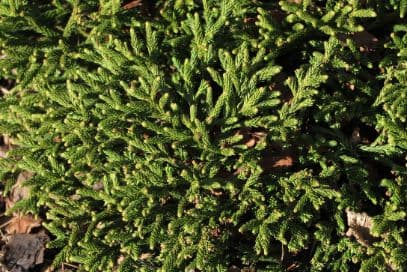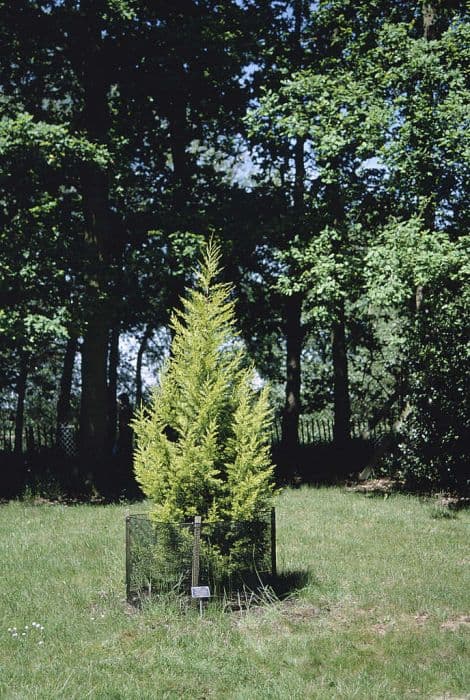Giant Sequoia Sequoiadendron giganteum

ABOUT
The common name for Sequoiadendron giganteum is the giant sequoia. The appearance of the giant sequoia is quite distinctive with a conical shape and a reddish-brown bark. The bark itself is very thick and deeply furrowed, providing the tree with protection from fires. The branches of the giant sequoia typically start high off the ground and extend outwards in a relatively symmetrical fashion. The foliage consists of two types of leaves: scale-like leaves found on older trees, and awl-shaped leaves that appear on younger trees, which are generally softer. The leaves cover the branches and are green, sometimes with a blueish tinge. The tree's overall silhouette forms a spire-like outline that is unmistakable on the landscape. The giant sequoia produces cones that are small and woody, usually around 1 to 3 inches long, which is modest in comparison to its overall grandeur. The seeds found within these cones are small and can be dispersed by the wind due to their light weight. In summary, the giant sequoia is a majestic evergreen tree with a broad columnar trunk, thick bark, and dense, green foliage. Its conical shape and reddish bark make it easily recognizable, while its small woody cones contain the tiny seeds of this iconic species.
About this plant
 Names
NamesFamily
Cupressaceae
Synonyms
Giant Sequoia, Giant Redwood, Sierra Redwood, Wellingtonia, Big Tree
Common names
Sequoia gigantea, Sequoia wellingtonia, Wellingtonia gigantea, Washingtonia californica.
 Toxicity
ToxicityTo humans
The Sequoiadendron giganteum, commonly known as the giant sequoia, is not generally considered toxic to humans. There are no well-documented cases of poisoning from ingesting or coming into contact with parts of the giant sequoia. Therefore, the likelihood of experiencing toxic symptoms from this tree is minimal.
To pets
The Sequoiadendron giganteum, commonly known as the giant sequoia, is also not known to be toxic to pets. It is not listed as a poisonous plant for animals such as dogs and cats, and there should be no toxic consequences from pets ingesting parts of this plant. However, it is always best to prevent pets from eating non-food plants as a general safety precaution.
 Characteristics
CharacteristicsLife cycle
Perennials
Foliage type
Evergreen
Color of leaves
Green
Height
250-275 feet [76-84 meters]
Spread
40-50 feet [12-15 meters]
Plant type
Tree
Hardiness zones
6-8
Native area
North America
Benefits
 General Benefits
General Benefits- Ecosystem Support: Provides habitat and food for wildlife, such as birds and small mammals.
- Carbon Sequestration: Captures and stores carbon dioxide, helping to mitigate climate change.
- Shade and Cooling: Offers extensive shade which can cool surrounding areas and reduce energy costs.
- Soil Stability: Extensive root systems help prevent soil erosion and maintain soil health.
- Cultural Significance: Known as Giant Sequoias, they have historical and spiritual importance for many people.
- Recreational Value: Attracts visitors for hiking and nature appreciation, supporting local economies.
- Longevity: As some of the oldest living organisms, they contribute to long-term ecological stability.
- Educational Resource: Serve as an outdoor classroom for teaching about ecology and conservation.
- Aesthetic Value: Their majestic appearance enhances the beauty of natural landscapes.
- Biodiversity: Promotes a variety of plant and animal life as a keystone species in its ecosystem.
 Medical Properties
Medical PropertiesThis plant is not used for medical purposes.
 Air-purifying Qualities
Air-purifying QualitiesThis plant is not specifically known for air purifying qualities.
 Other Uses
Other Uses- Giant sequoia bark can serve as insulation material due to its fibrous and thick properties, offering natural temperature regulation for small architectural projects or artistic installations.
- The tannins in giant sequoia bark have been historically used for tanning leather, providing a natural and traditional method for processing hides.
- Due to its decay resistance, wood from the giant sequoia is used for constructing outdoor furniture, offering a durable and long-lasting option for patios and gardens.
- The rot-resistant characteristics of the giant sequoia make it an ideal choice for making fence posts, ensuring a longer lifespan in varying weather conditions.
- Fallen giant sequoia trunks may be left in place in forests to serve as natural playground structures, providing an organic and adventurous setting for children to climb and explore.
- Giant sequoia trees have been utilized as living landmarks or natural monuments due to their massive size and distinct appearance, helping with navigation or marking special locations in parks.
- Tree-ring data from the giant sequoia is used in dendrochronology for studying historical climate patterns and providing insight into long-term ecological changes.
- The unique and grand stature of the giant sequoia is a source of artistic inspiration, often being featured in photography, painting, and literature as symbols of longevity and resilience.
- Wood from the giant sequoia can be crafted into musical instruments, such as specialty guitars, for a unique sound resonance and aesthetic appeal.
- The giant sequoia is sometimes planted in memorial parks and gardens as living memorials to honor individuals or significant events, growing as a symbol of remembrance.
Interesting Facts
 Feng Shui
Feng ShuiThe Giant Sequoia is not used in Feng Shui practice.
 Zodiac Sign Compitability
Zodiac Sign CompitabilityThe Giant Sequoia is not used in astrology practice.
 Plant Symbolism
Plant Symbolism- Longevity and Endurance: The giant sequoia is known for its incredible lifespan, with some specimens living for thousands of years, symbolizing durability and strength to continue and withstand the test of time.
- Majesty and Grandeur: Due to its towering presence and massive size, the giant sequoia signifies grandness and awe-inspiring might, often associated with elevated status and respect.
- Resilience: These trees have a remarkable ability to survive adverse conditions, representing the capability to endure hardships and recover from challenges.
- Connection to the Past: Given their ancient history and longevity, giant sequoias represent a link to the distant past and the continuation of life across centuries, reminding us of our heritage and history.
- Environmental Awareness: As an iconic species of the natural world, giant sequoias symbolize the importance of conservation, ecological balance, and the need to protect our natural environment.
 Water
WaterThe Giant Sequoia needs regular watering to keep the soil moist but not waterlogged. Young trees should be watered every 7 to 10 days with about 5 gallons of water, ensuring it reaches the roots. Mature trees require less frequent watering but in greater volumes, about every 2 to 4 weeks with 15 to 20 gallons, depending on the weather conditions and soil type. It's important to avoid overhead watering to minimize foliage diseases and to water early in the day to allow for evaporation.
 Light
LightGiant Sequoias thrive in full sun to partial shade. They should be planted in a location where they receive at least 6 hours of direct sunlight each day. These trees are adaptable but prefer bright, unfiltered sunlight for the majority of the day to promote healthy growth.
 Temperature
TemperatureGiant Sequoias are hardy and can tolerate a temperature range from about 20 to 90 degrees Fahrenheit, though they grow best in temperatures ranging from 60 to 85 degrees Fahrenheit. They are accustomed to cooler mountain climates and can withstand cold down to 20 degrees Fahrenheit without significant damage.
 Pruning
PruningPruning of a Giant Sequoia is generally not required as these trees have a natural form that is best left undisturbed. If necessary, light pruning to remove dead or broken branches should be done in the late winter or early spring, before new growth starts. This helps to ensure the tree heals properly and maintains its overall health and structure.
 Cleaning
CleaningNot needed
 Soil
SoilThe best soil mix for the Giant Sequoia should be well-draining and loamy, with the addition of organic matter such as compost to aid moisture retention and provide nutrients. The ideal pH range for this tree is between 6.0 and 7.0, slightly acidic to neutral.
 Repotting
RepottingGiant Sequoias, when grown in containers as juveniles, should be repotted every few years to accommodate their rapid growth. However, as they mature, repotting is not viable due to their massive size.
 Humidity & Misting
Humidity & MistingGiant Sequoias thrive in environments with high humidity; however, they are adaptable and can tolerate a wide range of humidity levels as long as their soil moisture needs are met.
 Suitable locations
Suitable locationsIndoor
Not suitable for indoor growth due to massive size.
Outdoor
Plant in full sun, well-draining soil, and ample space to grow.
Hardiness zone
6-8 USDA
 Life cycle
Life cycleThe giant sequoia (Sequoiadendron giganteum) starts its life when seeds, released from mature cones often following a fire, germinate in mineral-rich soil with ample sunlight and moisture—conditions typically resulting from a forest fire clearing. Seedlings establish a taproot and begin to grow rapidly, forming a modest woody stem and a sparse canopy of blue-green juvenile leaves. As saplings, they start developing the characteristic thick, fibrous, reddish-brown bark, which protects against fire and insect damage, and their leaves transition to the scale-like adult form. Upon reaching maturity, which can take several hundred years, giant sequoias may soar over 300 feet and begin to produce cones; however, cones can take 10 to 20 years to mature and typically require a fire or other environmental trigger to release their seeds. Mature trees continue to grow in girth and may produce thousands of cones over their lifetime, which can span several millennia, making them some of the oldest living organisms on Earth. Throughout its life, a giant sequoia will compete for sunlight, water, and nutrients, and it may be subjected to various natural disturbances, demonstrating remarkable resilience and adaptability.
 Propogation
PropogationPropogation time
Spring to Summer
The most popular method of propagating the Giant Sequoia, or Sequoiadendron giganteum, is through seed collection and sowing. This process typically begins by collecting cones in late autumn or winter. The cones, which are naturally designed to release seeds in response to the heat from forest fires, may require exposure to high temperatures to open. This can be simulated by placing the cones in an oven set at about 200°F (93°C) for a duration to gently coax them open without harming the seeds. Once the seeds are extracted, they should be surface sown on a well-drained, sandy potting mix, as they require light to germinate. It's important to keep the soil consistently moist but not waterlogged. Seedlings usually appear in the spring if sown in the winter, and patience is required as germination rates can be low and sporadic.









